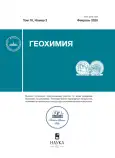Особенности морфологии и образования двойников прорастания кубических кристаллов алмаза
- Авторы: Павлушин А.Д.1
-
Учреждения:
- Институт геологии алмаза и благородных металлов СО РАН
- Выпуск: Том 70, № 2 (2025)
- Страницы: 146-157
- Раздел: Статьи
- URL: https://journal-vniispk.ru/0016-7525/article/view/294901
- DOI: https://doi.org/10.31857/S0016752525020032
- EDN: https://elibrary.ru/GPUTLD
- ID: 294901
Цитировать
Аннотация
В статье приводится кристалломорфологический анализ двух аналогичных по форме двойников прорастания кубических кристаллов – именного алмаза «Китайский фонарик» (Архангельская алмазоносная провинция) из коллекции компании «АЛРОСА» и бразильского алмаза, подробно описанного академиком А.Е. Ферсманом. Сопоставление результатов изучения этих алмазов, выполненного с использованием оригинальных методик интерпретации морфологических признаков роста и растворения кристаллов, позволило выявить ряд кристалломорфологических особенностей, характерных для закономерных сростков данного типа. Кроме типичных для кубоидов тетрагональных ямок, лентообразной, зубчатой и каплевидной форм скульптуры микрорельефа растворения поверхности, на архангельском алмазе обнаружен новый тип симметричного микрорельефа пилообразной формы, связанного с травлением октаэдрических слоев роста кубоида. По высоте заложения и направлению ступеней рельефного узора определена последовательность появления перечисленных типов микрорельефа по мере увеличения глубины растворения и степени изменения кривизны поверхности тетрагексаэдроида на двойниках кубоидов. Раскрыта природа происхождения характерной для двойников прорастания экваториальной гряды октаэдрических граней, в виде острого гребня, опоясывающего шов двойникования между кубоидами. Показано, что ее появление связано с ранним этапом закономерного срастания волокнистых кубоидов алмаза и является основным условием его возникновения, сначала в виде двойника прорастания плоскогранных октаэдрических кристаллов. Обсуждается сходство кристалломорфологических признаков растворения кривогранных кубоидов из кимберлитов Архангельских трубок и россыпных источников Бразилии и севера Якутской алмазоносной провинции.
Полный текст
Об авторах
А. Д. Павлушин
Институт геологии алмаза и благородных металлов СО РАН
Автор, ответственный за переписку.
Email: pavlushin@diamond.ysn.ru
Россия, 677000, Якутск, пр. Ленина, 39
Список литературы
- Афанасьев В.П., Ефимова Э.С., Зинчук Н.Н., Коптиль В.И. (2000) Атлас морфологии алмазов России. Новосибирск: Изд. СО РАН, НИЦ ОИГГМ, 298 с.
- Бартошинский З.В., Квасница В.Н. (1991) Кристалломорфология алмаза из кимберлитов. Киев: Изд. Наукова думка, 172 с.
- Кудрявцева Г.П., Посухова Т.В., Вержак В.В., Веричев Е.М., Гаранин В.К., Головин Н.Н., Зуев В.В. (2005) Атлас. Морфогенез алмаза и минералов-спутников в кимберлитах и родственных породах Архангельской кимберлитовой провинции. М.: Изд. Полярный круг, 624 с.
- Кухаренко А.А. (1955) Алмазы Урала. М.: Государственное научно-техническое издательство литературы по геологии и охране недр, 513 с.
- Орлов Ю.Л. (1963) Морфология алмаза. М.: Изд. АН СССР, 236 с.
- Орлов Ю.Л. (1984) Минералогия алмаза. М.: Изд. Наука, 264 с.
- Павлушин А.Д., Зедгенизов Д.А., Пироговская К.Л. (2017) Кристалломорфологическая эволюция роста и растворения кривогранных кубических кристаллов алмаза из россыпей Анабарского алмазоносного района. Геохимия. (12), 1141-1152.
- Pavlushin A.D., Zedgenizov D.A., Pirogovskaya K.L. (2017) Crystal Morphological Evolution of Growth and Dissolution of Curve-Faced Cubic Diamonds from Placers of the Anabar Diamondiferous Region. Geochem. Int. 55(12), 1153–1163.
- Павлушин А.Д., Бардухинов Л.Д., Коногорова Д.В. (2021) Алмазные раритеты: Китайский фонарик. Наука из первых рук. 92(3/4), 44–53.
- Ферсман А.Е. (1955) Кристаллография алмаза. Л.: Изд. АН СССР, 568 с.
- Aoki Y. (1979) Morphology of crystals grown from highly supersaturated solutions. Mem. Sci., Kyushu Univ., Ser. D. 24(2), 75–108.
- Сasanova R. (1972) A Repeated Twin in Natural Diamond from Tortiya, Ivory Coast. American Mineralogist. 57, 1871– 1873.
- Fersmann A., Goldschmidt V. (1911) Der Diamant. Eine Studie Miteinem Atlas von 43 Tafeln. Heidelberg: Carl Winters Universitätsbuchhandlung, 274 p.
- Garanin V., Garanin K., Kriulina G., Samosorov G. (2021) Diamonds from the Arkhangelsk Province, NW Russia. Springer International Publishing AG, Switzerland, 248 р.
- Goldschmidt V. (1904) Zur Mechanik des Lösungsprozesses. Zeitschr. Krist. 38, 656.
- Goldschmidt V., Wright. (1903) Über Atzfiguren, Lichtfiguren und Lösungskörper. N. Jahrb. Miner. 17, 355.
- Goldschmidt V., Wright. (1904) Über Lösungskörper und Lösungs-Geschwindigkeiten. N. Jahrb. Miner. 18, 335.
- Lu T.J., Ke J., Qiu Z.L. (2018) Surface dissolution features and contact twinning in natural diamonds. J. Mineral. Geochem. 195, 145–153.
- Machado W.G., Moore M., Yacoot A. (1998) Twinning in Natural Diamond. II. Interpenetrant Cubes. Journal Applied Crystallography. 31, 777–782.
- Senechal M.L. (1976) Geometry and Crystal Symmetry. Neues Jahrbuch Mineralogie. Monatsh. (11), 518–524.
- Spetsius Z.V., Taylor L.A. (2008) Diamonds of Siberia: Photogtraphic Evidence for their Origin. Tranquility Base Press: Lenoir City, Tennessee, USA, 278 p.
- Sunagawa I. (1984) Growth of Crystals in Nature. In Materials Science of the Earth’s Interior. Terrapub: Tokyo, Japan, 63–105.
Дополнительные файлы


















